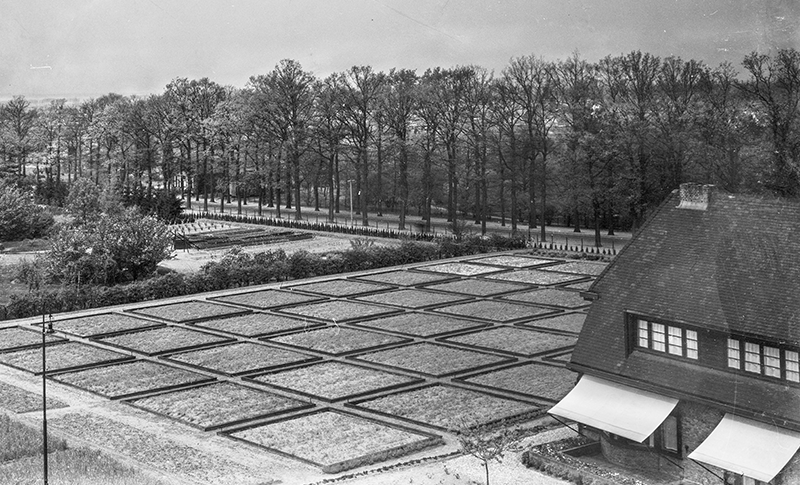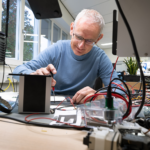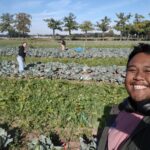The test plots used by the microbiologist Söhngen are exactly one century old. This national monument has been repurposed as a vegetable garden.
Of the 60 official heritage structures in Wageningen, the former Microbiology test plots may well be the least widely known and the least visible. Not many people realize there are allotments next to the former Unitas building on the General Foulkesweg. They are tiny little gardens and are just five years old. They owe their status as a monument to their history and significance as cultural and scientific heritage.
What are now vegetable gardens started out exactly a century ago as test plots for the Laboratory for Microbiology next door. Forty plots of six by seven metres were arranged in a block of eight rows of five. The complex was built in 1921 by Nicolaas Söhngen, the first professor of Microbiology at the Agricultural College that was then just three years old.
Söhngen was lured to Wageningen from the National Agriculture Testing Centre in Groningen in 1917 by the prospect of becoming a professor there. A campus was planned on the Wageningse Berg for the new Agricultural College, which would include a lab for microbiological research. A lab was certainly sorely needed, as Söhngen was still doing experiments in his house on the Herenstraat.
A visionary
But the campus did not materialize: the Upper House of the Dutch parliament scrapped the plan in September 1919. To save money, writes Gert van Maanen in a recently published book on the history of the test plots. Van Maanen, editor-in-chief at BioNieuws, has an allotment on test plot number 12. Remarkably, though, in the same month Söhngen did get the green light to build a lab, a house for himself and one for his gardener, and the test plots. How the persistent professor managed that is anyone’s guess, says Van Maanen. ‘There is nothing about it in the official documentation. He seems to have financed it himself, largely.’
In the light of today’s nitrogen and climate crises, you could call Söhngen a visionary
The first experiments took place at this location in 1921. Söhngen focused his research on the effect of fertilization and bacteria on soil fertility and crop growth, paying special attention to the role of nitrogen-binding bacteria. The plots consist of sandy and clay soils mixed with peat litter. Adding calcium-rich marlstone created variety in acidity levels. Thanks to the detailed lab journal kept for 20 years by Söhngen’s close colleague Klaas Wieringa, we can still follow the exact course of the experiments.
In the light of today’s nitrogen and climate crises, you could call Söhngen a visionary, says Van Maanen. ‘He put the quality of the soil first. What happens in the soil that determines whether crops grow? What does it mean if we use artificial fertilizer? He was not against this but did point out the dangers of using it excessively, whereas most people at the time were all in favour of artificial fertilizer. And that kind of emphasis on soil life and cycles is seen as very modern now.’
Heritage
Söhngen died at the age of 56 in 1934. Wieringa praised him in an obituary as an original thinker and ‘a genius’. According to Wieringa, Söhngen attached ‘far more importance to experiments than to theoretical ideas’. Söhngen’s successors shifted the emphasis from field research to the study of bacteria in the lab. The last experiments in the test plots took place in 1987, and they have looked abandoned and overgrown ever since. In 1999 they narrowly escaped demolition by building contractor Roelofs en Haase, to whom WUR sold off the complex. In Van Maanen’s view, that was a typical example of how badly WUR treats its heritage. ‘Why would you do something like that? Why sell it? And if you have to, set some conditions that certain elements must stay intact. We could have had here the longest-running historic fertilization experiment in the country, or maybe even in Europe. But there just isn’t anyone at WUR who is bothered about that.’
The demolition plan did set something in motion, however. One of the repercussions was that the test plots were designated a National Monument two years later. Not that that changed their sorry state of repair. Until the artist Christien Meindertsma used the plots in 2013 for her exhibit in the art exhibition Beelden op de Berg. She turned 10 of the plots into little fields of bright blue flax in honour of the successful flax variety Chantal. This inspired local residents to turn the test plots into allotments and to form De Proefvakken gardening association five years ago.
Has that saved the test plots? Not entirely. The building contractor is to be allowed to sacrifice two rows of plots, 10 in total, to build a new apartment block. The same number of plots on the other side of the complex have given way to a strip of greenery adjoining the housing there. That leaves half of the original 40 plots. Kept in memory of Söhngen and his pioneering work. What would the professor think of that? ‘I think he would be disappointed that they are lost to science,’ says Van Maanen. ‘But maybe he would also like the fact that people are still growing food on them and are thinking in terms of cycles.’

 The test plots photographed from the Laboratory for Microbiology. Söhngen’s house (since demolished) is in the corner on the right. Photographer: unknown.
The test plots photographed from the Laboratory for Microbiology. Söhngen’s house (since demolished) is in the corner on the right. Photographer: unknown. 

